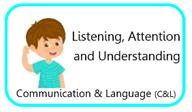

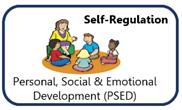

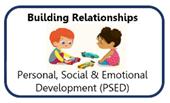

Begin to listen to longer stories.
Recall some key events from a story.
Begin to pay attention to more than one thing at a time.
Understand 2 step simple instructions.
Understand and answer why questions.
Respond appropriately during a conversation.
Retell familiar nursery rhymes.
To retell number rhymes. Be able to speak using 4 – 6-word sentences.
Take turns speaking and listening during a conversation.
Ask why questions during a conversation.
Use talk to organise their play
Enjoy listening to longer stories and can remember much of what happens.
Develop their communication, but may continue to have problems with irregular tenses and plurals, such as ‘runned’ for ‘ran’, ‘swimmed’ for ‘swam’.
Develop their pronunciation but may have problems saying some sounds
To be able to follow a onestep instruction.
To talk about themselves. Be able to sit during a short circle time
Follow a 2-step instruction.
Share how they are feeling with a member of staff.
To sit during circle time and join in a class session.
E.g. math’s and RWI
Start to understand feelings. (happy, sad and tired)
Begin to follow rules. Develop ways of being assertive.
Begins to take turns. Play with one child extending and contributing during play.
Shows they are able to follow rules.
Able to take turns in roleplay. Play with one and more children, extending and contributing during play.
Start to understand feelings. (happy, sad, tired, worried, angry and scared)
Able to choose resources to help them achieve.
Begin to understand how someone else might feel. Show confidence with others during a social situation.
Develop their sense of responsibility and membership of a community
Become more outgoing with unfamiliar people, in the safe context of their setting. Develop appropriate ways of being assertive. Remember rules without needing an adult to remind them.
Be increasingly independent as they get dressed and undressed, for example, putting coats on and doing up zips.
Be increasingly independent in meeting their own care needs, e.g. brushing teeth, using the toilet, washing and drying their hands
Make healthy choices about food, drink, activity and toothbrushing
Talk with others to solve conflicts
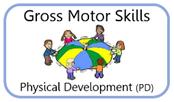


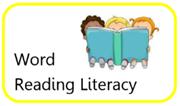

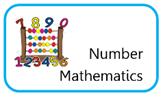
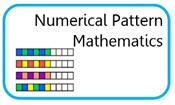
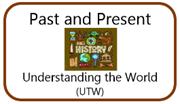
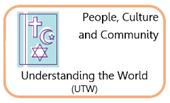
Explores moving their body in different ways.
Shows can use a onehanded tool.
Begin Dough Disco
Moves body to music showing when they can stop and start.
Makes snips in paper using scissors.
Begin Squiggle Wiggle
To be able to control a ball in different ways, balance on a variety of equipment and climb
Child shows a preference for a dominant hand.
To jump and land safely from a height.
Joins in with repeated phrases for familiar stories.
Expresses simple likes about a shared story.
Discriminates between sounds in the environment.
Develops book handling skills.
Answers who and what questions linked to stories shared.
Begin to hold a pencil with a modified tripod grip to show control.
Begin name writing if ready
Expresses simple likes and dislikes about a shared story.
To move safely with confidence and imagination, communicating ideas through movement.
Demonstrate a growing independence putting on a coat and shoes, begin to do zips.
Can follow instructions in simple races, running at speed and an obstacle course.
Shows ability to use a knife and fork.
Choose the right resources to carry out their own plan. For example, choosing a spade to enlarge a small hole they dug with a trowel.
Collaborate with others to manage large items, such as moving a long plank safely, carrying large hollow blocks
Uses new vocabulary in their play.
Uses new vocabulary in conversations.
Can clap syllables.
Begin RWI for ones that are ready
Can draw a straight line.
Begin Dough Disco
Can draw curved lines in both clockwise and anticlockwise directions.
Begin Squiggle Wiggle
Recognition of up to 3 objects. Counts accurately to 3.
Ascribes meanings to marks during play
Can recognise rhymes. Engage in extended conversations about stories, learning new vocab.
Responds to focus texts through mark making.
Begin name writing if ready.
Subitising of up to 2 objects. Can count 5 objects from a larger group. Subertising 3, composition of 4 & 5.
Begins to recognise colors and how to match & sort.
Counts accurately to 5.
AB Pattern, begin to understand ABC pattern.
Begins to compare quantities within 5, recognising 6
Rote Counts accurately to 10 Height &Length Mass Capacity
Beginning to record some sounds in sequence.
Begin forming RWI sounds if ready.
Uses more or less, comparing numbers within 5.
Begin to Identifiy initial sounds
Understand the five key concepts about print: - print has meaning - the names of the different parts of a book - print can have different purposes - page sequencing - we read English text from left to right and from top to bottom
Write some or all of their name.
Develop their phonological awareness, so that they can: - spot and suggest rhymescount or clap syllables in a word - recognise words with the same initial sound, such as money and mother
Write some or all of their name. Write some letters accurately.
Can use key language total/altogether. What comes before/after?
Sequencing Positional language
Beginning to understand shapes
Solves problems with numbers up to 5.
Say one number for each item in order: 1,2,3,4,5. Know that the last number reached when counting a small set of objects tells you how many there are in total (‘cardinal principle’). Talk about and explore 2D and 3D shapes (for example, circles, rectangles, triangles and cuboids) using informal and mathematical language: ‘sides’, ‘corners’; ‘straight’, ‘flat’, ‘round’.
Talk about their immediate family and their role in the family.
To talk about the concept of growing up.
Knowing who is in their family and why they are special to them.
I can comment on recent photos and pictures of celebrations in my own life, e.g. This is me at … my birthday, Christmas, Diwali or Chinese New Year. I can comment on fictional/historical figures or familiar objects or situations from the past.
Know about family celebrations.
Know about events celebrated by different groups of people. Know about events celebrated by different groups of people. Valentine’s Day & pancake day
Know that Easter has been celebrated for many years.
I can comment on fictional/historical figures or familiar objects or situations from the past, St Georges Day
Know about who celebrates Easter and why we celebrate Easter.
Know about events celebrated by different groups of people.
Celebrating St Georges Day.
Share and understand how they have grown and changed.
Begin to make sense of their own life-story and family’s history. Finding out about the Past. Exploring changes over time.
Celebrating leaving Nursery and starting Reception.
Show interest in different occupations.
Continue to develop positive attitudes about the differences between people.
Know that there are different countries in the
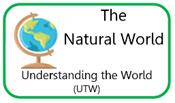

Explore changes in Autumn.
Explore what happens on cold winter days.
I can tell you about different body parts and what is unique about me. I can talk about the pets I have and the features of different animals.
I can examine animals to find out more about them. I use my senses to explore.
Explore collections of materials with similar and/or different properties.
Woodland/ park animals- Labelling, Habitats. getting ready for winter.
Use all their senses in handson exploration of natural materials
Talk about taking care of the world around us. Changes in Spring
Know that there are different places in the world
Show interest in different occupations. Know about people who help us and understand how people help us.
I show awareness of change, as I can talk about the differences between materials and changes that I notice using simple terms to describe.
I can examine animals to find out more about them. I use my senses to explore.
Know that there are different countries in the world and talk about the differences they have experienced or seen in photos.
I can examine animals to find out more about them. I use my senses to explore.
Explore changes in Summer. I know that directions can be followed and lead to different places
I know that a map has places/features on and what it is used for.
I can use the correct basic scientific vocabulary to describe parts of animals. I can explain a simple lifecycle,
Can examine plants to find out more about them. I use my senses to explore and take care of them.
I can explore collections of different materials with similar and different properties. Boats/ floating & sinking.
I can examine animals to find out more about them and label some body parts. I use my senses to explore. I can talk about where they live and what they do.
Science- Forces using puppets, reading pop-up books, performing action rhymes, threading beads, digging and lifting sand, riding bikes, weaving and playing percussion instruments
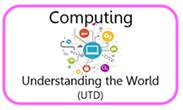
I can turn on the music centre and select music.
I can ask an adult to help me with technology
Internet safety

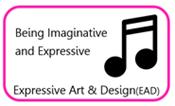
Join different materials together.
I can use a touchscreen to open and close apps
I can find the correct app with adult help
Internet safety
Make choices about which materials to use when creating.
I can listen to and play digital stories
I can explore technology in the home and wider world
I can talk about different digital devices
Internet safety
Create closed shapes with continuous lines.
I can use pretend technology in my role play
I can make toys work using buttons/switches
Internet safety
I can take a photograph
I can put simple instructions in order I can create a sequence of instructions
Internet safety
Create a card experimenting with colour and texture.
Represent feelings, noises and movements through drawing.
I can take turns on a digital device
I can make music on an iPad
Internet safety
world and talk about the differences they have experienced or seen in photos.
Plant seeds and care for growing plants.
Begin to understand the need to respect and care for the natural environment and all living things.
Talk about the features on a map and following directions to get to a different place.
Use all their senses in hands-on exploration of natural materials. Explore collections of materials with similar and/or different properties. Talk about what they see, using a wide vocabulary. Explore and talk about different forces they can feel.
Explore how things work
I can tell a trusted adult if something on the screen upsets me I can talk about ways to stay safe when I am using a digital device I know passwords help keep information safe online. I can create rules for using technology responsibly
Join in with simple repetitive rhymes and songs.
Perform songs and dances in a Christmas performance.
Explore sounds that can be made from percussion.
Follows teachers signals/instructions when playing instruments (play and stop)
Create own songs using musical accompaniments.
Share likes and dislikes about a piece of music.
Explore color mixing. Begin to develop complex stories using small world equipment like animal sets, dolls and dolls houses etc. Make imaginative and complex ‘small worlds’ with blocks and construction kits, such as a city with different buildings and a park. Explore different materials freely, in order to develop their ideas about how to use them and what to make.
Draw with increasing complexity and detail, such as representing a face with a circle and including details. emotions in their drawing.
